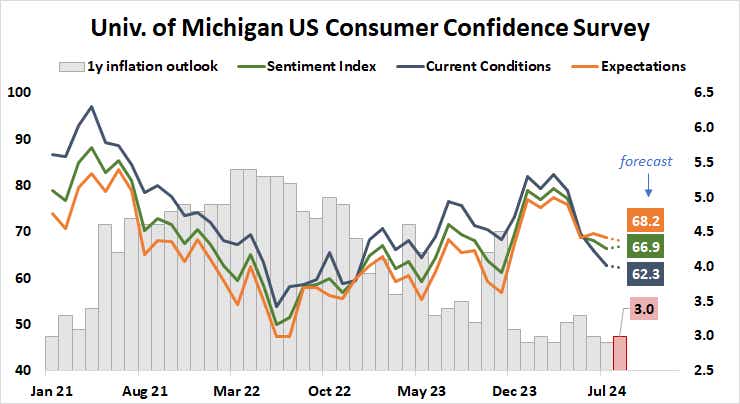Will U.S. Consumer Confidence Data Make or Break the Market?

Will U.S. Consumer Confidence Data Make or Break the Market?
By:Ilya Spivak
Stocks roared higher as strong U.S. retail sales cooled recession fears. A sentiment report is up next.
Stock markets cheered as strong U.S. retail sales data marked down recession risk.
Fed policy bets shifted to reflect diminished rate cut urgency, sending bonds lower.
The focus now turns to U.S. consumer confidence data for the next inflection point.
Stock markets roared in approval as U.S. retail sales data sailed past economists’ consensus forecasts. Receipts jumped 1% in July after a 0.2% decline in June. Vehicle sales drove the increase. Excluding autos, sales rose by a more modest 0.4%. July CPI data published yesterday revealed a steep year-on-year decline in vehicle prices.
The bellwether S&P 500 stock index is on track for a gain of 1.4% following the data. The tech-tilted Nasdaq 100 is pacing to close up over 2% while the small-cap Russell 2000 has added 2.8%. Treasury bonds fell as the upbeat numbers cooled Federal Reserve interest rate cut expectations, weighing on yields.
Stocks surge as strong retail sales data cools U.S. recession fears
The priced-in probability of a double-sized 50-basis-point (bps) rate reduction at the U.S. central bank’s September meeting—the next time that the rate-setting Federal Open Markets Committee (FOMC) will gather to decide policy—has dropped. It now stands at 25.5%, down from 55% a week ago.

Fed Funds interest rate futures now imply 75bps in rate cuts in 2024, a drop from 104bps recorded amid the market rout last Monday. That amounts to factoring out a full 25bps rate cut from the forecast. That easing has migrated into next year. The outlook for 2025 now envisions 128bps in cuts, up from 105bps seen after last week’s mayhem.
This reshuffling suggests a diminished sense of urgency in deploying stimulus, implying that imminent recession fears have cooled. That’s not surprising in the wake of robust retail sales data. Household consumption is the leading driver of U.S. economic growth, accounting for close to three-quarters of demand.
All eyes on U.S. consumer confidence report
From here, the spotlight turns to the latest survey of consumer confidence from the University of Michigan (UofM). It is expected to show a slight improvement in respondents’ mood in August after hitting an eight-month low in July. The release may help decipher whether last month’s retail sales momentum has scope to continue.

Sentiment was steadily improving as inflation expectations were declining since mid-2022 as the Fed’s rate hike cycle started in March of that year began to bear fruit. That trend held until June of this year, when lower price growth estimates lost their ability to uplift consumers’ mood.
This probably reflects the cooling of the labor market that the Fed itself cited when it switched gears in July to signal the central bank is now “attentive to the risks to both sides of its dual mandate.” This implies policymakers are now about as worried about rising unemployment as they are about inflation.
That narrative pivot marked the latest swing top in the S&P 500 as the markets reckoned that the Fed has become worried about an unwelcome slowdown after four months of increasingly underwhelming economic data (according to analytics from Citigroup). When soft inflation and employment numbers followed, stocks swooned.
With this in mind, soft sentiment data—especially in the context of still-anchored inflation expectations—may take some of the wind out of Wall Street’s sails and put a cap on upward progress, at least for now. On the other hand, a chipper reading echoing the apparent resilience of the retail sales report may furnish her ally with added fuel.
Ilya Spivak, tastylive head of global macro, has 15 years of experience in trading strategy, and he specializes in identifying thematic moves in currencies, commodities, interest rates and equities. He hosts Macro Money and co-hosts Overtime, Monday-Thursday. @Ilyaspivak
For live daily programming, market news and commentary, visit tastylive or the YouTube channels tastylive (for options traders), and tastyliveTrending for stocks, futures, forex & macro.
Trade with a better broker, open a tastytrade account today. tastylive, Inc. and tastytrade, Inc. are separate but affiliated companies.
Options involve risk and are not suitable for all investors. Please read Characteristics and Risks of Standardized Options before deciding to invest in options.
tastylive content is created, produced, and provided solely by tastylive, Inc. (“tastylive”) and is for informational and educational purposes only. It is not, nor is it intended to be, trading or investment advice or a recommendation that any security, futures contract, digital asset, other product, transaction, or investment strategy is suitable for any person. Trading securities, futures products, and digital assets involve risk and may result in a loss greater than the original amount invested. tastylive, through its content, financial programming or otherwise, does not provide investment or financial advice or make investment recommendations. Investment information provided may not be appropriate for all investors and is provided without respect to individual investor financial sophistication, financial situation, investing time horizon or risk tolerance. tastylive is not in the business of transacting securities trades, nor does it direct client commodity accounts or give commodity trading advice tailored to any particular client’s situation or investment objectives. Supporting documentation for any claims (including claims made on behalf of options programs), comparisons, statistics, or other technical data, if applicable, will be supplied upon request. tastylive is not a licensed financial adviser, registered investment adviser, or a registered broker-dealer. Options, futures, and futures options are not suitable for all investors. Prior to trading securities, options, futures, or futures options, please read the applicable risk disclosures, including, but not limited to, the Characteristics and Risks of Standardized Options Disclosure and the Futures and Exchange-Traded Options Risk Disclosure found on tastytrade.com/disclosures.
tastytrade, Inc. ("tastytrade”) is a registered broker-dealer and member of FINRA, NFA, and SIPC. tastytrade was previously known as tastyworks, Inc. (“tastyworks”). tastytrade offers self-directed brokerage accounts to its customers. tastytrade does not give financial or trading advice, nor does it make investment recommendations. You alone are responsible for making your investment and trading decisions and for evaluating the merits and risks associated with the use of tastytrade’s systems, services or products. tastytrade is a wholly-owned subsidiary of tastylive, Inc.
tastytrade has entered into a Marketing Agreement with tastylive (“Marketing Agent”) whereby tastytrade pays compensation to Marketing Agent to recommend tastytrade’s brokerage services. The existence of this Marketing Agreement should not be deemed as an endorsement or recommendation of Marketing Agent by tastytrade. tastytrade and Marketing Agent are separate entities with their own products and services. tastylive is the parent company of tastytrade.
tastyfx, LLC (“tastyfx”) is a Commodity Futures Trading Commission (“CFTC”) registered Retail Foreign Exchange Dealer (RFED) and Introducing Broker (IB) and Forex Dealer Member (FDM) of the National Futures Association (“NFA”) (NFA ID 0509630). Leveraged trading in foreign currency or off-exchange products on margin carries significant risk and may not be suitable for all investors. We advise you to carefully consider whether trading is appropriate for you based on your personal circumstances as you may lose more than you invest.
tastycrypto is provided solely by tasty Software Solutions, LLC. tasty Software Solutions, LLC is a separate but affiliate company of tastylive, Inc. Neither tastylive nor any of its affiliates are responsible for the products or services provided by tasty Software Solutions, LLC. Cryptocurrency trading is not suitable for all investors due to the number of risks involved. The value of any cryptocurrency, including digital assets pegged to fiat currency, commodities, or any other asset, may go to zero.
© copyright 2013 - 2025 tastylive, Inc. All Rights Reserved. Applicable portions of the Terms of Use on tastylive.com apply. Reproduction, adaptation, distribution, public display, exhibition for profit, or storage in any electronic storage media in whole or in part is prohibited under penalty of law, provided that you may download tastylive’s podcasts as necessary to view for personal use. tastylive was previously known as tastytrade, Inc. tastylive is a trademark/servicemark owned by tastylive, Inc.